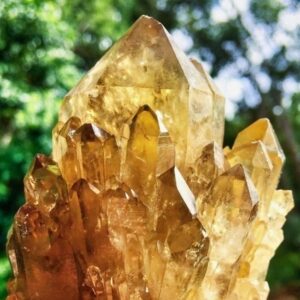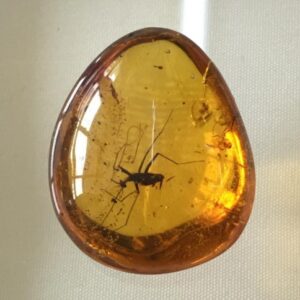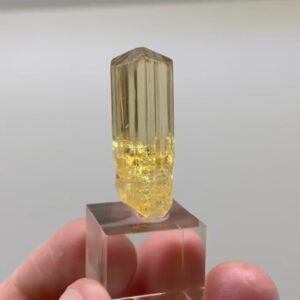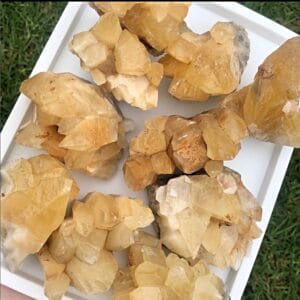From beautiful, bold, sunny colors to deep, rich golden hues, yellow crystals, and gemstones are incredibly warm and inviting. While yellow crystals might not be as commonly purchased or sought-after by some collectors, many know and appreciate their true value.
Before we get started we should take a minute and talk about the color yellow. I know this sounds boring but it is important if you’re a buyer or collector. Pure yellow is going to be the most valuable, but secondary colors can be present. Secondary hues in yellow stones are orange, green, and brown. Green secondary shades are typically undesirable on the market.
Orange secondary hues are typically preferable. For instance, golden colors display slight orange hues.
Yellow Crystal Names
So many types of yellow crystals and gemstones to research and collect. I thought it would be good to create a list of my favorite ones to collect. Most of these crystals are easy to obtain online or from a rock and gem show. However, there are a few that are quite expensive and one of them is fairly rare and very difficult to source.
If you’re new to collecting crystals and gemstones then here are a few guidelines I stick to when buying yellow crystals. First of all, you want the crystal to be in good condition which means the tips are not broken and the overall crystal structure is intact. Secondly, you want the color to be vibrant or glowing if possible. The best to to see this is to put the crystal on a white background and see how bright the color is.

Citrine
Citrine crystals are the most common type of yellow crystals because they’re readily available and affordable. You can find very bright-colored crystals and gemstones in this material. Crystals can be harder to come by if you’re looking for larger pieces. If you want the very best Citrine on the market then you should do some research on Madera Citrine.
Some crystals will show various secondary colors like yellow, greenish-yellow, brownish-yellow, or orange.

Amber
Amber is interesting because you can source pure yellow, honey yellow, or a yellowish orange. You’ll have to determine your favorite flavor of color and go hunting for an amazing piece. If you find a nice specimen with insects or organic material then it’s a bonus.
If you want the very best Amber then you probably want to research the highly valued reddish-hued variety.

Sapphire
Sapphires that range from colorless to yellow to intense orange hues naturally react differently to heat or light depending on the material’s nature and the color’s origins. There are actually seven different types of Yellow Sapphire on the market currently, and each differs in the cause of color and the stability of color.
There is something unique about a highly saturated yellow Sapphire when you see it in person. The yellow is glowing under the light.

Topaz
Topaz crystals come in a variety of colors and yellow can be a little difficult to find compared to Swiss blue, London blue, pink, and white. Today, “Yellow Topaz” refers only to this crystal’s yellow hue, and don’t confuse it with Imperial.

Yellow Diamond
Yellow Diamonds are categorized in the special family of fancy-colored diamonds. Regular everyday diamonds that, due to impurities found in them (a mere fluke of nature), change their color during their formation process, which makes them anything but regular. In case you didn’t know, there are different color grades for fancy yellow Diamonds. If you’re interested in learning more then here’s the shortlist; fancy light, fancy, fancy dark, fancy intense, fancy deep, and fancy vivid.

Golden Apatite
Yellow or Golden Apatite is a mineral belonging to the family of calcium phosphate minerals. The stones are commonly found in igneous, sedimentary, and metamorphic rocks around the globe. The hues of Yellow Apatite range from pale yellow to deep golden hues, and the stones often appear transparent to translucent.

Scapolite
Scapolite crystal’s colors and properties vary according to the amount of calcium and sodium in their chemical composition change. Colors range from nearly colorless through pinks and purples to yellow and orange hues. By far, yellow shades occur most commonly, with purple coming in a distant second.

Golden Beryl Heliodor
Golden Beryl derives its yellow coloring from small iron deposits but please remember it will always be yellow. I tell you this because collectors just starting out have a tendency to confuse Golden Beryl with Heliodor. Heliodor is a variety of Beryl but it will have orange hues mixed in with the yellow.
Gem and specimen dealers love to call Golden Beryl, Heliodor, because they can charge more.

Yellow Kornerupine
Kornerupine crystals come in various colors, ranging from brown to lovely shades of emerald green, blueish-purple, and yellow. These stones have distinctive trichroic pleochroism which means they will display multiple colors when rotated under light. Because of the stone’s incredible rarity, Kornerupine is highly sought-after by collectors and enthusiasts.

Golden Calcite
Golden Calcite, which is also known as Amber Calcite and Honey Calcite. These crystals are readily available online or at rock and gem shows. If you don’t feel like buying them then you might want to consider digging them out of the ground.
Calcium carbonate is the primary mineral component of these beautiful crystals.
The stone’s color palettes can range from pale gold, golden, or brown hues, which are transparent to semi-transparent.
Dark Yellow Crystals
Many of the dark yellow crystals have more golden hues that are deeper and darker than lighter shades.

Yellow Gypsum
Gypsum is typically clear to white and kind of boring when you think about it but Yellow Gypsum crystals are pretty amazing. Take a look at the image above. That’s an amazing specimen and the golden yellow is very intense. Most Gypsum occurs in its massive form as layers of rock that are often intercalated layers of shale, dolostone, or limestone. Alabaster is one of the common names used for exceptionally pure deposits of massive Gypsum.

Bumble Bee Jasper
Contrary to its name, Bumble Bee Jasper isn’t a true variety of Jasper since it doesn’t contain Quartz. The stone’s vivid colors of yellow, orange, black, and gray banding are composed of fibrous calcite, pyrite, and realgar. The name comes from the fact that the stones appear similar to bumble bees’ color patterns.

Golden South Pearl
There are quite a few varieties of cultured pearls and they get their naming convention from their color. Golden South Pearls are very expensive and highly sought-after by high-net-worth individuals. When you see these pearls in person they almost look fake.
Why You Need to Collect Yellow Crystals
Yellow crystals are stunning, beautiful, warm, and inviting. Of all the crystals, yellow, whether light, pale, or golden and dark, are among the most attractive to collectors and enthusiasts.
While red and green stones are the most prized and seemingly rare, yellow hues seem to shine bright in an unsurpassable way.
Don’t forget to take a look at my other articles about crystals. Here’s a complete write-up about Types of Purple Crystals.
- Identify Enstatite - March 12, 2024
- Identify Cerussite - March 3, 2024
- Identify Bytownite - February 18, 2024
